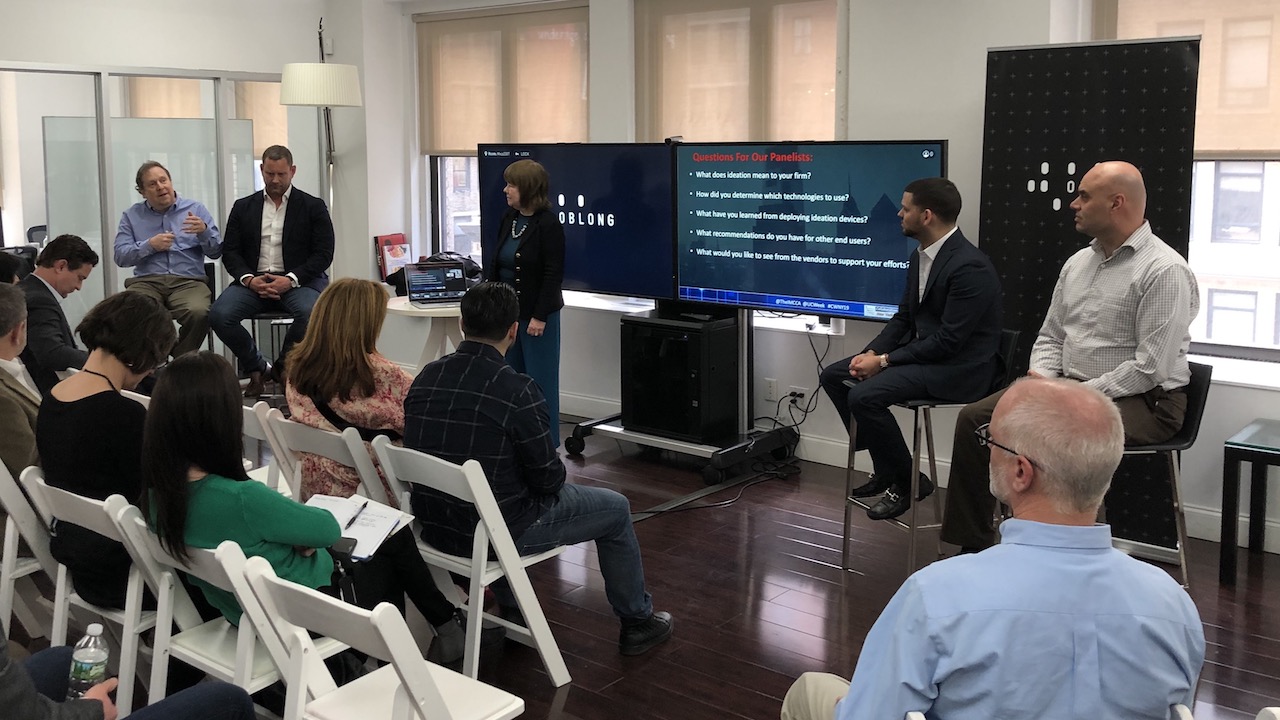It’s one of the most heart-wrenching sights a technology provider or manager will see: a facility decked out with cutting-edge interactive displays, and nobody using them. Their touch pens have long gone missing, and would-be users have simply fallen back to using old-fashioned dry-erase boards and paper flip charts.

“What [the users we surveyed] basically said to us was when we get into an environment where things are not working, we go back to what we’re familiar with,” said Dr. S. Ann Earon, IMCCA’s chairperson emeritus. “And if that means we’re using [paper] handouts, we’re using handouts.”
Avoiding this kind of technological travesty was a focal point of discussions at Oblong’s offices on Tuesday afternoon, during day two of IMCCA’s Collaboration Week New York. The event, titled “Interactive Displays and Ideation,” featured an introductory presentation by Earon, followed by a panel discussion, and was capped off by an enlivening look into the future of group work by Oblong’s CEO John Underkoffler.
Through an engaging discussion between the audience and Earon, and later, the panel, the event distilled the cause of underutilized technology down to two main factors: insufficient consultation with organizations on what they need to use the technology for, and insufficient training on it.
Here are some takeaways on how these issues can be overcome:
Get to know the users’ needs
“You need to get the users invested in the project, and that means asking questions about how it’s going to be implemented, how it’s going to be used, and how it’s going to be supported,” said Citigroup’s Marc Cooper during the panel discussion. “Doing a proof of concept and getting your users to try this before you do a huge rollout or a giant commitment is going to be very important. And it’s also very important that you standardize on one solution, so if you know how to use it in one room, you can use it in all the rooms.”
“‘Take me through one of your meetings,’ is a great question to start with,” said Leonard Suskin of Spectra Design. “‘What’s the meeting like? Does someone chair it?’ And the answers to those lead to other follow-ups.” Suskin also likened the conversation to the process of buying the right car: don’t ask the users what kind of car they want; lead them to the right choice by asking them what kind of driving they do.
Educate strategically
“We make the mistake with a lot of these technologies of teaching people everything it can do [at once], when we need to start small and teach them what they need at that moment, then add onto it,” Earon said. “When you do everything at once, they don’t remember it all, and they just don’t want to admit that they forgot the training, nor do they want to read a manual, look at a video, or go to a training class.”
Earon also pointed out that it’s important to focus on promoting a culture of adoption within the company, and cited studies that have shown that it’s best done from the top level down, with a CEO mandate to start using the new technology.
Continuing to educate
Earon said she has found that if people don’t use a technology within 3–4 weeks after their initial training, they won’t remember how to use it. “Don’t just go in and do one training session; go in and find their pain point, and help them solve their problem,” she said. “And once you’ve solved their problem, go in and say ‘You know you asked me to come in and solve this problem, now I’ve got a whole host of other ways you could be using this. Oh, and by the way, you’ve done so well with this, would you be our spokesperson within the company, so we can shepherd you around to everyone else as to how great this worked?’”
Oliver Henderson of Kinly agreed with the need for follow-ups by way of intracompany spokespeople. “It’s not a one-off thing; people need refresher courses. People are busy and have lots on their plate,” he said. “And putting in a good system of having evangelists throughout the company and educating those evangelists. I know of a Fortune 500 company that just ditched $750,000 worth of hardware because the evangelists for those products had left the company.”
McKinsey & Company’s Richard Ramm shared that his company has found success in holding regular gatherings to use the technology and build comfort. “I would recommend the [tech manager] taking the time to learn the technology, then share it with the people you work with,” he said. “One thing we do is host social groups where we bring in a few of our key end users to come together and share how they’re using the system and the success that they’ve had.”
See other coverage of IMCCA's Collaboration Week New York here:
